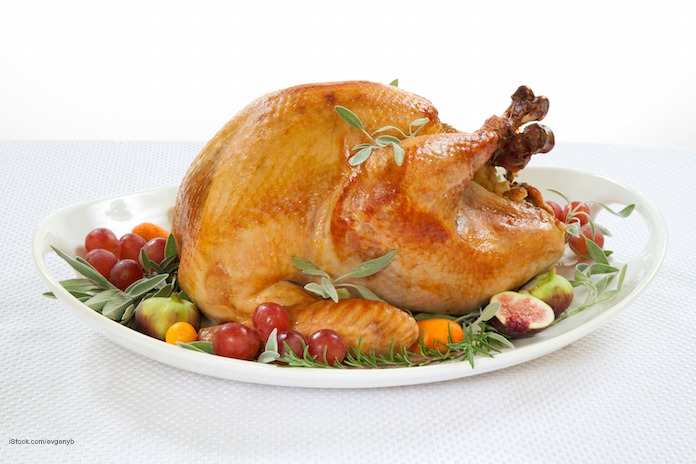Thanksgiving is Thursday! Most people will be having turkey and stuffing. Read on to learn how to safely prepare a turkey for Thanksgiving dinner. While this task isn’t difficult, there are some rules you should follow to avoid food poisoning. The Centers for Disease Control and Prevention (CDC) has tips.

First, plan ahead. If you buy a frozen turkey it needs time to thaw – in the refrigerator. Never thaw a turkey on the counter or you are inviting trouble. Allow 24 hours of thawing for every four to five pounds of bird. If you have a big turkey, it may be too late at this point. In that case, you still have options.
You can thaw the turkey in cold water, but you have to keep an eye on it. Make sure the turkey is in a leakproof bag before you put it in the sink. Add cold water to completely cover the bird and let stand 30 minutes (wash your hands!). Then drain the water and add more. Continue to change the water every 30 minutes until it is completely thawed. This will take 30 minutes per pound. Roast this turkey as soon as it’s thawed. And you’ll need to clean your sink with a mild bleach solution after the turkey is in the oven because the sink will be contaminated.
You can also thaw your turkey in the microwave oven. Follow the manufacturer’s instructions. Again, roast or grill the turkey immediately when you use this method. And clean your microwave.
Or you can cook your turkey from frozen. This method also has the advantage of no raw juices that can drip around the kitchen. Just be careful, since that frozen turkey is slippery.
Never wash a raw turkey. This action will aerosolize the bacteria on the turkey and spread it around your kitchen. Just pat it dry with paper towels.
Watch out for cross-contamination. Raw poultry and juices can contaminate anything in your kitchen, including the counters, utensils, platters, sink, drawer pulls, and your hands. Wash your hands thoroughly before and after handling the turkey. Keep the raw turkey away from foods that are eaten uncooked. Never put cooked turkey on a plate or other surface that held raw turkey. And wash utensils, dishes, the countertop, and cutting boards with hot soapy water after they have touched raw turkey.
Experts recommend that you do not stuff a turkey because of the risk that bacteria in the stuffing will not be killed by the heat. Dr. Keith Warriner of the Ontario Agricultural College says that stuffing insulates the bird, preventing hot air from cooking the inside.
Cook stuffing in a casserole instead. If you do want to stuff it, add the stuffing just before cooking. Never stuff a turkey ahead of time. When the turkey (and stuffing) is done, let it stand for 20 minutes, then remove the stuffing.
Both the turkey and stuffing must be cooked to 165°F and that temperature must be measured with a food thermometer. The oven temperature has to be at least 325°F; don’t use any recipes that call for a lower temperature. Check the temp in the thickest part of the breast, where the body and thigh join, and where the body and wing join. Test it even if the turkey has a pop-up indicator.
Then carve your turkey and enjoy Thanksgiving now that you know how to safely prepare a turkey.
But don’t forget about leftovers! The turkey must be put in the fridge two hours after it comes out of the oven, or one hour if the air temperature is 90°F or above. Cut the turkey into smaller pieces so it cools down more quickly. And use the leftovers within four days, and reheat them to at least 165°F before serving.




